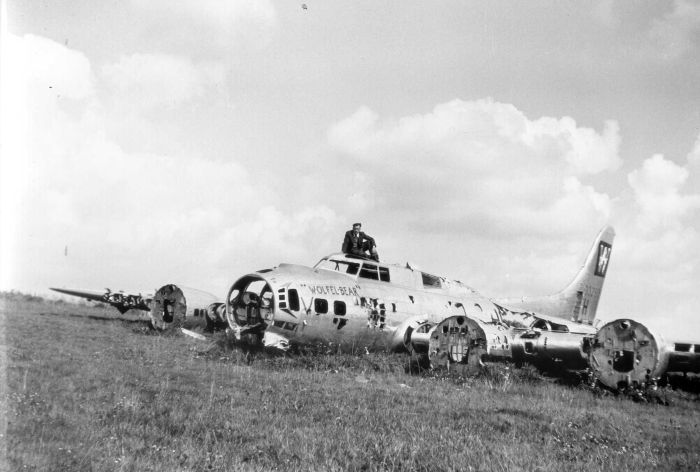 |
"Wolfel Bear," #908:H8:H On, November 10th, '44, LT Dimel and crew were forced down in Belgium, near Bastogne. LT Dimel and crew safely landed with no injury to crew. The photo above shows the state of #908 May or June of 1946 after souvenir hunters, and salvors had completed their work. The gentleman sitting atop "Wolfel Bear" is Mr. Firmin Roulin. Mr. Roulin was a member of the Belgian Army and was wounded and captured during the German invasion of Belgium. He was held near the German city of Bobstadt, and after his repatriation worked for the Belgian railway. Firmin Roulin was a private in an engineering unit of the Belgian Army, which was surprised by the first round of attacks by Ju 87 (Stuka) dive bombers. 20 of the 24 man unit were killed, and 3 were wounded. Firmin was one of the wounded and was initially treated in Brussels before being moved by train to France, not far from Dunkerque. The train, marked with red crosses, was also attacked by Stukas, and Firmin escaped injury. The German captures took their captives on a 4 week march into Germany and internment. The prisoners were barely fed and received little water. One prisoner attempted to drink water from a ditch, and was shot by a German guard. The prisoners were then sent as slave labor to various jobs in factories, harbors, and farms. Firmin, being wounded, was not initially selected, but did eventually wind up working as a farm hand on a German farm. Every night, the workers were locked up in the mayor's house, with guards posted. Following the battle of Stalingrad, the outlook of the local German's began to change as men returned from the Eastern front, wounded or dead. The locals became more friendly toward their captives. However, the treatment still varied between those forced to work in the factories and those on the farms. To ensure no fraternization took place between farm workers, and their masters, the farm workers were rotated to different farms. Treatment of Polish, Russian and Partisan prisoners was much harsher. The final disposition of the aircraft is unknown, but it was most likely cut up for scrap. According the Claude Roulin, the perspex was used to make crosses, perhaps in memory of the crew. (Photos and information courtesy of Claude Roulin, Belgium). |